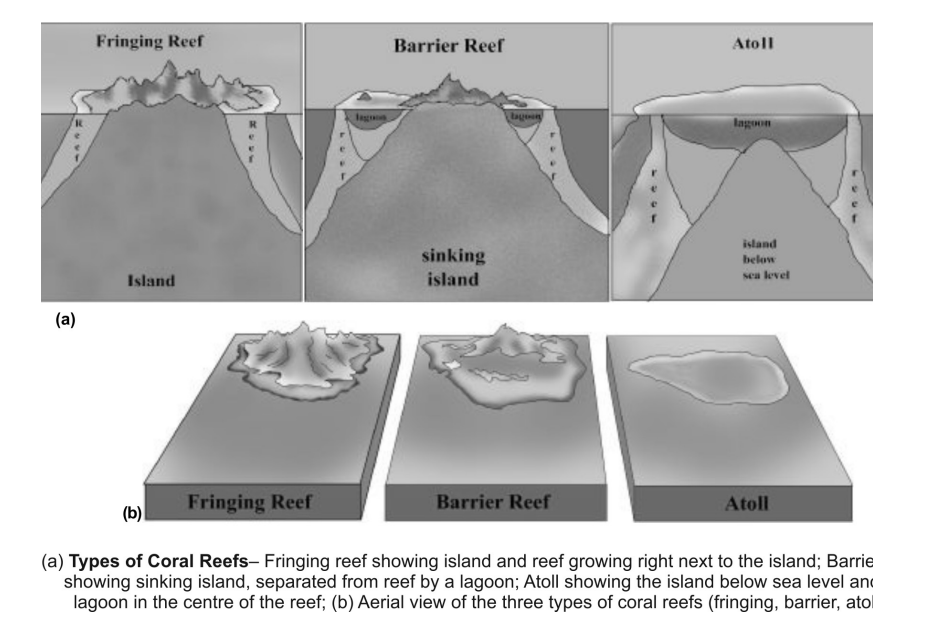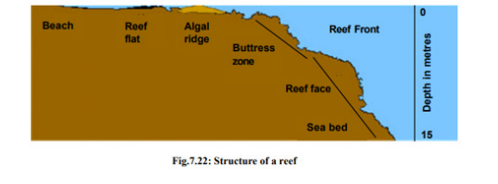Terrestrial-and-aquatic-ecosystems / Terrestrial and Aquatic Ecosystems / Coral Reefs and Coral Bleaching
Coral Reefs

- Coral reefs are found in shallow waters surrounding land masses in tropical water. They are restricted to waters warmer than 18 °C, generally in a band that lies between the Tropic of Cancer and the Tropic of Capricorn. In addition to warm water, corals require high-salinity and silt-free water.
- There are three main types of coral reefs. They are the atoll reefs, barrier reefs and fringing reefs. Atoll and barrier reefs are fully developed and are considered mature corals. Both are characterized by a lagoon that is protected on the seaward side by the reef. Fringing reefs are considered immature because they have not yet produced a lagoon between the reef and its associated land mass.
- Coral reefs are the most productive systems in the marine environment. They harbour a large number of marine species.
Groups of corals found on reefs
Two groups of corals are found on a reef. They are the hermatypic corals and ahermatypic corals.
- Hermatypic corals or stony corals: Hermatypic corals are those that build coral reefs (stony corals). They are found in the tropics. Typically stony corals are colonial. They contribute to the production of reef limestone, and form calcium carbonate skeletons. The stone corals are of two types: Frame builders and rapidly growing branched forms.
- The frame builders include the genus Montastrea and Astrea (star corals) Meandrina, (brain corals). These are usually slow growing massive corals which form bulk of the reef.
- The branched corals are represented by the genus Acropora and Tubipora.
- Ahermatypic corals or soft corals: Ahermatypic corals are distributed worldwide and do not form reefs as they do not secrete calcium carbonate. Instead of a hard calcareous skeleton they have a flexible protein-like skeleton at the core of the coral. The soft corals include sea pens, sea fans, whip corals and pipe corals.
The structure of Coral Reef
- Coral reef morphology is complex. The degree of exposure and the amount of wave action is of particular importance in determining reef structure. Most reefs have a number of general features including the reef terrace or reef flat, the algae ridge, the buttress zone and reef face.
- The surface of the reef is the terrace, or reef flat. Its elevation is at an average low water so the coral reef community is periodically exposed during the period of low tides.
- The seaward edge of the coral reef generally has an algal ridge that is at a slightly higher elevation than the reef flat. Algal ridge takes the force of the breaking waves and is constantly awash from the movements of surf and surge.
- Towards the sea and below is the buttress zone, which reduces the force of the breaking waves on the algal ridge. The buttress zone deflects and channels waves so that they tend to be directed upward over the algal ridge. In this way the destructive energy of waves is dissipated over the seaward edge of the reef. Below the buttress zone is the fore reef, or reef face, which extends to the bottom.
- Growth of the coral reef is greatest on the algal ridge, the buttress zone and the seaward portion of the reef terrace. The farther from the outer reef edge, the lesser the favourable conditions for reef growth.

Coral Bleaching
- When corals face stress by changes in conditions such as temperature, light, or nutrients, they expel the symbiotic algae zooxanthellae living in their tissues, causing them to turn completely white. This phenomenon is called coral bleaching.
What triggers coral bleaching?
- Change in ocean temperature - Increased ocean temperature caused by climate change is the leading cause of coral bleaching.
- Runoff and pollution Storm generated precipitation can rapidly dilute ocean water and runoff can carry pollutants — these can bleach near-shore corals.
- Overexposure to sunlight - When temperatures are high, high solar irradiance contributes to bleaching in shallow-water corals.
- Extreme low tides - Exposure to the air during extreme low tides can cause bleaching in shallow corals.
Can coral recover from bleaching?
- Coral is the world’s longest-living species, capable of growing for centuries in the right circumstances. As a result, coral colonies frequently die as a result of a dismal living environment or the extinction of other organisms. Bleached reefs, on the other hand, can survive based on the extent of the bleaching and the return of standard sea temperatures.
Mass Coral Bleaching:
- When the El Nino weather phenomenon forced sea temperature in the Pacific Ocean to heat up, the first massive bleaching event happened in 1998, killing 8% of the world’s reefs.
- In 2002, the 2nd incident happened. However, mass bleaching events have been more closely placed in time over the last decade, with the longest and most devastating bleaching event occurring from 2014 to 2017.
- Reefs in Guam, in the Western Pacific, were the first to be devastated, followed by reefs in the North, South, and Indian Oceans. In 2017, the global average temperature was the 3rd hottest ever measured. In comparison to 1998, more than thrice as many corals were susceptible to bleaching-level extreme heat during the 2014-17 period.
- The Great Barrier Reef in Australia is witnessing its fourth mass bleaching incident since 2016. This is the fourth time in six years that such extreme and extensive destruction has been discovered as a result of rising sea temperatures.
Steps taken to protect and restore corals
- Coral reef protection and restoration is central to the UN Decade on Ecosystem Restoration (2021-2030) geared towards the restoration of degraded and destroyed ecosystems to enhance food security, clean our air quality, secure water supply, address the climate crisis and protect habitats that support life on earth as we know it.
- The UN Decade of Ocean Science for Sustainable Development (2021-2030) also puts a spotlight on coral reefs to inspire advances in science and technology to improve ocean health.
- UN Environment Programme (UNEP) has been promoting international cooperation and evidence to support the protection management and restoration of coral reefs, and related ecosystems such as seagrass and mangroves.

